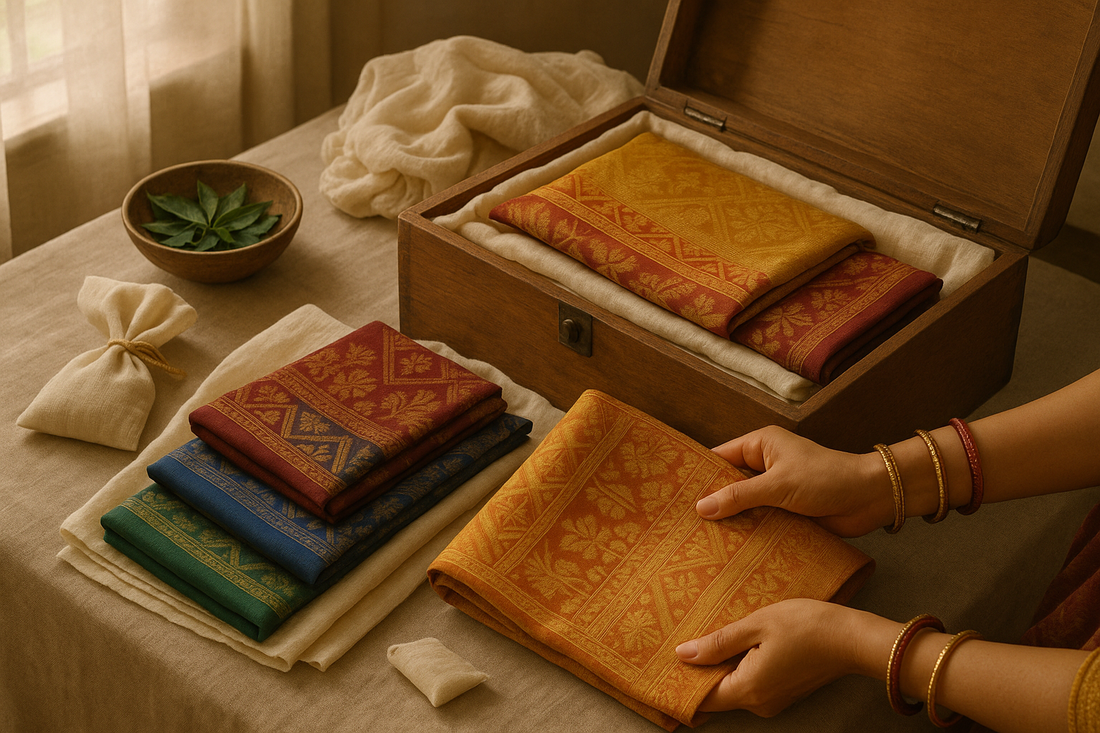
How to Care for Silk Jamdani Sarees | Expert Dry Cleaning Guide for Wedding & Designer Sarees
Share
A Gentle Art – The Care of Your silk jamdani saree Collection
Every saree has a tale to tell—of heritage, talent, sentiment, and grace. Whether it is an heirloom handwoven silk Jamdani sarees or the latest additions to your wedding saree collection, they all need a different type of care. But how can this artistry of these intricate weaves and embellishments be preserved? The solution is inherent in one crucial method: dry cleaning.
In this exhaustive guide, we take a deep dive into dry cleaning your saree – why it’s essential, which fabrics need it most, what happens during the process, and how to ensure your favorite sarees continue to sparkle for generations.
Chapter 1: The Essence of Dry Cleaning with respect to Sarees
1 What Is Dry Cleaning?
Dry cleaning is the process of cleaning soft fabrics without using water but a form of solvent such as carbon tetrachloride or trichloroethylene to clean the fabrics. Must smust.. Also good for quite fragile stuff like silks and organzas, chiffons and georgettes..
2 Risk of Home Washing
If Water is utilised to wash Sarees at home, then there will be:
Color bleeding
Fabric shrinkage
Weakened zari work
Damage to embroidery or embellishments
Dull (Lustre is lost in new Sarees)
Which is why dry cleaning isn’t some ridiculous luxury, it’s a form of fine fabric medical care.
What Is Dry Cleaning?
1 Variations in The Dry Cleaning Procedure
The dry cleaning process involves:
Pre-treatment of stains
Solvent (Perchloroethylene or hydrocarbon) dip 3 rub using a minimum of 3…
Gentle mechanical cleaning
Drying and finishing (pressing/steaming)
This way the tissue like fabric stays safe without any wetness or rubbing that could work really great for a purple wedding saree or for any other heavily embellished outfit.
Chapter 2:
-
Sarees Requiring Dry Cleaning
2.1 Silk Jamdani Sarees:
-
Silk Jamdani Saree is a stunning combination of the Bengal’s traditional craftsmanship over rich Silk. They are also delicate and intricately woven, which makes them vulnerable to water damage. how to: Dry-clean silk Jamdani Story: Cultural context.
-
Retain the vibrancy of threads
-
Prevent fraying of motifs
-
Protect delicate textures and handwork
2.2 Pure Silk Sarees:
-
Kanjeevaram, Banarasi, Mysore – all of these are some of the most prestigious saree materials which you may want to gift. Its fiber is all about resistant moisture since it's made of protein (dry cleaners are encouraged in order to keep this:)
-
Natural sheen
-
Color richness
-
Zari integrity
2.3 Embroidered and Designer Sarees:
-
Heavy embroidery, sequins, mirrors, beads and handwork can come off or lose its shine if washed at home. It contains a bunch of new sarees or the limited-edition designer sarees from your new festive wardrobe.
Dry cleaning:
-
Keeps the embellishments intact
-
Doesn't clump or rip in the machine wash
-
Offers light press without harming delicate work
2.4 Velvet and Net Sarees:
Velvet and net have a tendency to attract dust and are very delicate in nature. Velvet in particular crushes, and net snags readily. Dry cleaning helps:
Clean without distortion
Maintain drape and stiffness
Remove stains without residue
Chapter 3: The Items You Can Skip Dry Cleaning
3.1 Cotton and Daily-Wear Sarees
Cotton or linen sarees for daily wear (without any zari/gold embellishment or any other heavy work) generally can be hand-washed. However, always:
Use cold water
Avoid wringing
Dry in shade
3.2 Synthetic Fabrics
For polyester/rayon sarees, you may not have to go for dry cleaning, unless there are adornments. These are hardier types but do appreciate the occasional gentle wash.
3.3 Light Georgette or Crepe
Some lighter georgette saris with no die work or sequins can even be hand washed in cold water. But when in doubt, dry clean to prevent regret.
Chapter Four:
Guide to Dry Clean By Type Of Saree
4.1 Silk Jamdani Saree
-
How Often: Every 1–2 wears (ideally, each time if you wear them for long periods)
-
Tip: Wrap in muslin and air before sending for dry cleaning
4.2 Purple Wedding Sarees:
-
Your purple wedding sarees are the statement of grace and not to forget a lifetime moment. 100% silk, 92% silk, 8% elastane, 100% polyester; trim: 100% polyesterDry clean:
-
After each wedding function
-
Before long-term storage
4.3 Saree Collection for Wedding
-
Whether you are a bride or a guest, your wedding sarees collection can have designer sarees, organza, tulle and what not. These must be:
-
Dry cleaned after every wear
-
Stored in individual garment bags
-
Two (2) side-handles, lid, and front-flap for easy carrying and use Check moisture and moth once a year.
4.4 New Sarees from Online Shopping
And if you’re a saree enthusiast who has bought designer sarees online, be sure to refer to the label or ask the seller about fabric care. If it’s got zari, sequins, or a delicate fabric — dry clean is the safer option.
How to Determine the Saree Needs Dry Clean?
Dullness in fabric sheen
Visible perspiration or food stains
Slight discoloration near the pleats
Rigid to touch or zari falling apart.
Slight odor not removable by rinsing with water
The care of Saree fabric starts with the looking after part. You don’t want to wait until damage is irreversible.
Chapter 6:
- Saree Care: Home Vs Professional Treatment
-
Feature
-
At Home
-
Dry Clean
-
Risk of color bleeding
-
High
-
Minimal
-
Damage to zari
-
High
-
Low
-
Embroidery preservation
-
Poor
-
Excellent
-
Fragrance & freshness
-
Short term
-
Long-lasting
-
Cost
-
Low
-
Medium-High
-
Longevity of saree
-
Low
-
High
-
As part of your saree fabric care routine, dry cleaning is recommended for:
-
Heirloom pieces
-
Occasional wear sarees
-
Designer items
-
Use gentle handwashing for:
-
Casual cotton sarees
-
Non-embellished synthetics
Chapter 7:How To Drape The Saree As Soon As It's Out From The Dry Cleaner’s:
7.1 Folding and Wrapping
Layer a sheet of acid-free tissue paper or soft cotton fabric over the top of each layer before folding.
Do not put in COLOR plastic (green or brown) bags or PAPER bags of any kind.
7.2 Storage Environment
Store in cool, dry place
Avoid direct sunlight
Remove any form of moisture such as * silica gels, desiccant etc.
7.3 Refolding Every Few Months
Expose your sarees In 3-4 months in order to avoid marking lines as part of your saree for an extended time. If its silk Jamdani saree then you just cant keep folding in same line every time.
Chapter 8: Saree Dry Cleaning FAQs:
-
Q1. Are all types of silks sarees dry cleanable?
-
Yes, ALL Pure silk Sarees need to be only dry cleaned to maintain their texture, shine yet add years to saree!
-
Q2. How often should I dry clean my wedding sarees?
-
After every use, or at least once a year if never used. Always before long-term storage.
-
Q3. Can we dry clean old sarees?
-
Absolutely. But for something that old, there’s so dry cleaning a vintage sari in delicate fabric’s is probably best than washing,” she said.
-
Q4. Are there fabric care instructions available with the sarees online?
-
It talks about tag or product page description on most of high quality saree new sarees &Some tip to get the right saree. Ask the seller if you're not sure.
-
Q5. What do I ask for at the dry cleaner?
-
Ask them if they are specialised in ethnic wear or silk
-
Inquire about the solvent type
-
Request a Test Clean on Rare or Expensive Sarees
Source: greentopics. org 166 9 Cleaner Side, Dry cleaning etc.
9.1 Solvent Awareness The most commonly used method for cleaning clothes is the “dry cleaning with perchloroethylene”, which is a cancer-causing chemical that is bad for the environment and for a person’s health. Ask for: Green dry cleaning options Hydrocarbon or silicone-based solvents
9.2 Waterless but Not Waste-less And while not water-powered, dry cleaning is an energy- and chemical-intensive affair. Opt for sustainable saree fabric care services.
-
Chapter 10: Final Tips – Blending Tradition with Modern Care
-
Don’t ignore small stains or loose threads; get them treated early Alternate storage locations every season Use saree bags with ventilation and avoid air-tight containers Air sarees out every few months in natural shade Always iron using a protective cloth on delicate sarees
Remember what was left behind, clean it up, and carry it on.
They're more than just clothes for you. People in the family love it, and it's also a work of art. They will stay beautiful for generations if you take good care of them and dry clean them carefully. Pay attention to them, whether it's a silk Jamdani saree for a family puja, a royal purple wedding saree that shines under the mandap lights, or your closet's most stylish saree for a wedding. Your sarees look great, smell great, and are clean, so let them shine.
